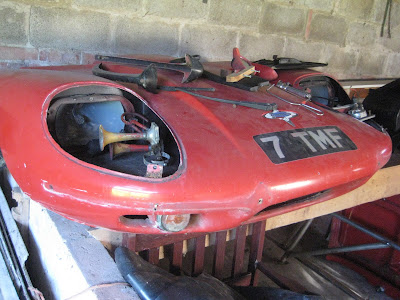After Yesterdays solid progress, I continued where I left off and decided to have a go at drilling out the rivets, (or very knackered screws as I later found them out to be) from the pedal Box cover. Fluids I think have caused these screws to be 'dissolved away' I used a bit of drilling together with some gentle persuasion from a hammer and a big handled screwdriver, managed to tap out the screw closest to the front bulkhead. the other stayed in its position but the box cover came away. it was necessary to unscrew the cable first from the back of the slave cylinder assembly as this cable runs through the side of the box and sort of keeps it there.
 |
| Drilling the first of the screws out. |
What I found at this stage was that tapping out the screws from this area washindered by the location of the bonnet catch and the stay behind it, I removed these, and of course both were completely different! the passenger side one was more substantial and had loads of washers attached to it as opposed to driver side that only had 1.
 |
| Driver's side Bonnect catch |
The camera had run out of juice by now and I had to resort to the phone so I hope the quality is ok!!!
The picture below shows the opposite side Bonnet clip and you can see the difference immediately to the drivers side one!
 |
| Washers between the outer part of the clip and the fibreglass (The Voltage regulator for the Dynamo marked 'Lucas' is fairly prominent too). I'm most likely going to use an alternator, so this part will be become redundant. |
I movedback to the pedal box at this point and took out the plastic surround from around the cyclinders etc. once I had disconnected the cable running from the pedals out to the carburettor.
 |
| Pedal Box showing to the right, the Steering rack coming down with an additional clamping mechanism that must be removed to allow the rack to come away from the rest of the mechanism. (Note Dynamo bottom right) |
|
Next up was the Radiator, oil cooler and fan dis-assembly, It was important to remove these parts so that the most amount of space could be gained to work (especially when removing engine and gearbox further down the line).
Looking at the rad there are four bolts, the bottom two were easy to remove, the top two there was only enough room to place a small adjustable spanner moving at one quarter turns each time, the rad had to be pulled forward to allow space for the bolt to work its way backwards sothat it could come off the screw thread.
Here I am removing the oil cooler, this wasnt really much of an obstacle, (even though the screws were rusty) just 4 secure this in total at the base of the unit.
Sowith the removal of the Fan, Radiator and water cooler from the front, the bay looks very sparse now!! there was a small leakage of water at this point (Orange water) this has obviously been in the pipe for some considerable time. and so it went everywhere!
Another view closer up of the front of the car One thing that has impressed me, is how the chassis looks in this incredibly 'exposed to the elements' area! I'm hoping the bits I can't see are at least as good as this. I know the rear sections in the wheel arch area are immaculate.
Another point I can bring up from Yesterdays workings, is the fact there are two flasher units in the car, my dad thinks there is a hazard warning system in place, that I don't think is put as standard on the V6's or indeed earlier cars?
(See Picture Below).
 |
| The main flasher unit is at the very top of the dash fascia, the additional one is cylinder that is on the end of the wires in my hand. |
Whilst pottering around the winscreen earlier it was clear that with the removal of the roof, this metal support has been put in place up to the top of the screen so this is a 'bonus' bit of strength for the screen which would otherwise be a major structuralpoint in just fibreglass!
Anyway this was the end of this weekends work It will be a couple of weekend before I can update but should be able to acomplish much much more in the next set of weekends.
Bye for now!
























































